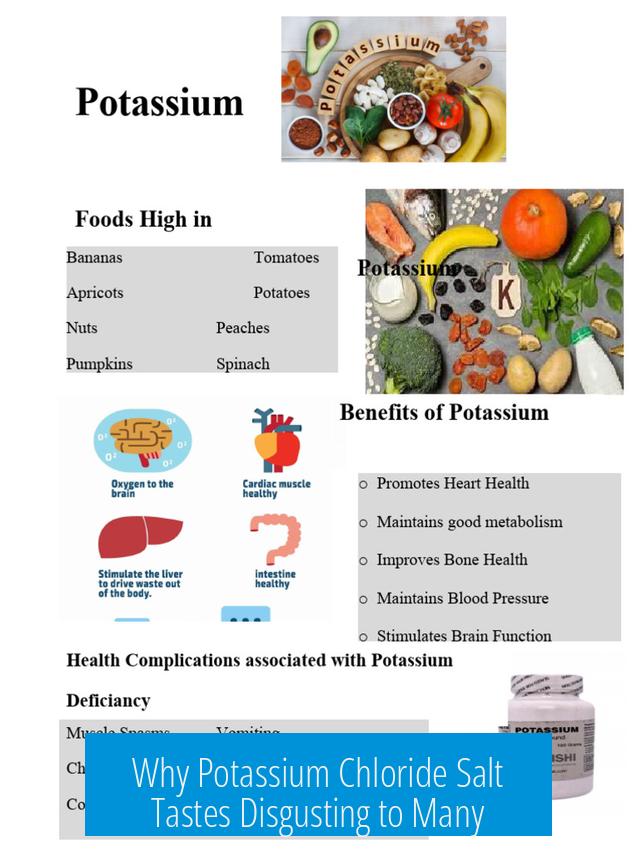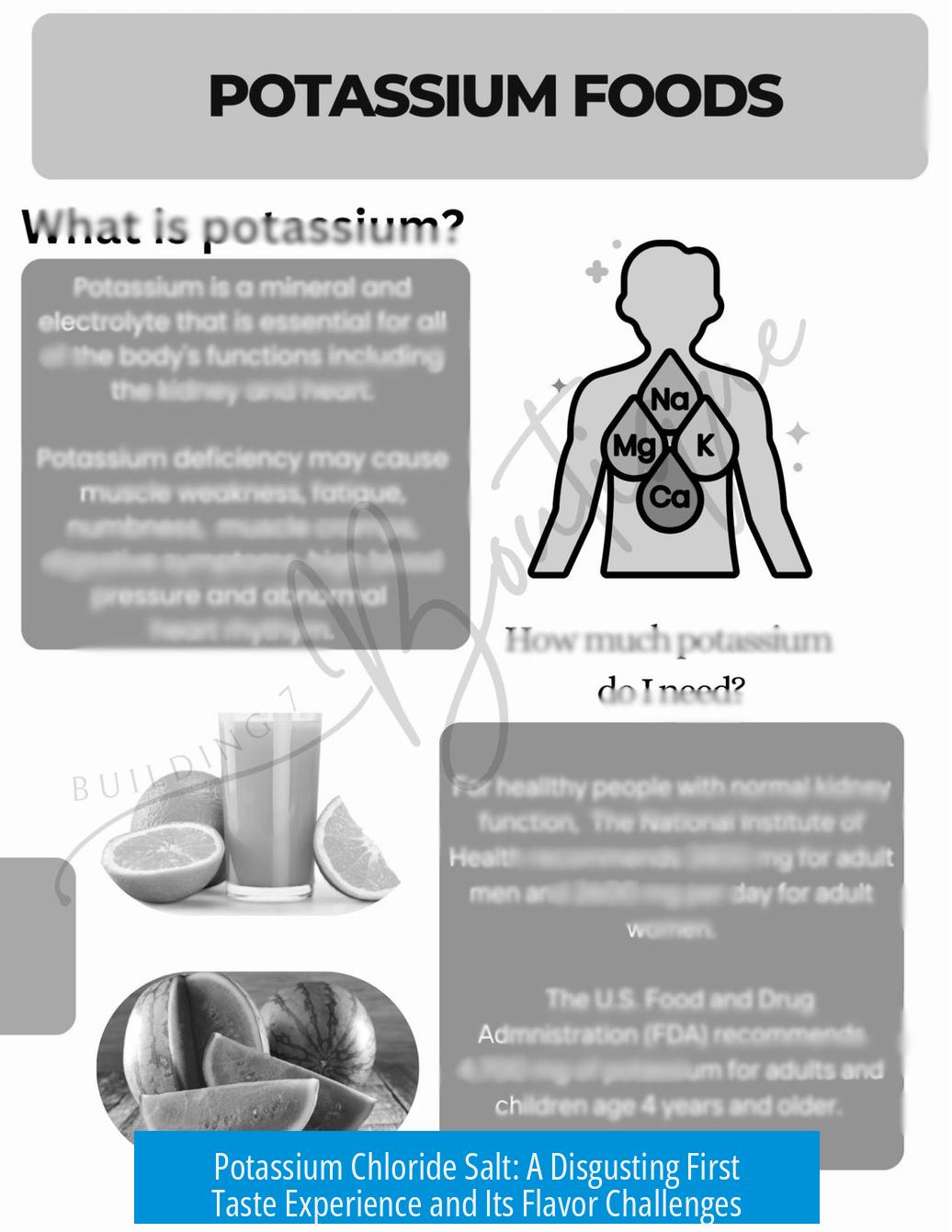Why Potassium Chloride Salt Tastes Disgusting to Many

Potassium chloride (KCl) salt often tastes unpleasant or “disgusting” to first-time users due to its distinct bitter, metallic, and sometimes tangy flavor that differs sharply from common table salt (sodium chloride, NaCl).
This reaction is common and well-documented, as potassium chloride cannot simply replace sodium chloride on a one-to-one basis without impacting taste. Understanding the differences in taste, potential adaptations, and blending methods helps clarify why KCl salt often draws negative sensory impressions.
Distinct Taste Profile of Potassium Chloride
Potassium chloride salt presents a complex flavor that many describe in unflattering terms. Typical taste impressions include:
- Bitter and metallic notes: Many consumers find KCl delivers an unpleasant metallic or bitter aftertaste.
- Tangy sensation: Initial tanginess or sour-like hints often appear before the salty flavor emerges.
- Overall harshness: Some compare the flavor to sewage or disagreeable chemical tastes.
These sensory properties explain why many people find KCl “gross” on first use and why the salt can be difficult to substitute directly for table salt in cooking or food seasoning.
Neuro Adaptation and Taste Acceptance

Taste buds and the brain’s perception of flavors adjust over time, a process known as neuro adaptation. This phenomenon helps explain variable responses to potassium chloride salt.
- People who transition slowly to low-sodium diets may find their taste buds adapt to less salt, improving tolerance for potassium chloride blends.
- Early exposure to KCl, such as in childhood, can condition taste preferences toward acceptance and even craving of its bitter notes.
- Late introduction of KCl in diets, especially without adaptation, often results in rejection or dislike.
Thus, time and familiarity with potassium chloride influence whether it tastes acceptable or disgusting to different individuals.
Strategies for Improving the Taste of Potassium Chloride
Direct substitution of sodium chloride with potassium chloride rarely produces pleasant results. Several techniques mitigate KCl’s off-flavors:
Blending With Sodium Chloride
- A common approach is mixing KCl with NaCl in a 1:1 or 1:2 ratio (potassium:sodium) to reduce the sodium content while preserving familiar saltiness.
- Commercial products often use a 2:1 sodium to potassium blend or adjust ratios depending on masking flavors.
Use of Flavor Masking Agents
- Sour or acidic substances like vinegar, lemon, or lime juice can mask bitterness.
- Additives such as dried milk powder soften potassium chloride’s sharpness.
- Sweet or semi-sweet mixes combined with KCl, such as in beverages with inositol, improve palatability.
Choosing Potassium Chloride Products With Fewer Additives
Some KCl salts contain additives that influence taste. Opting for purer products or brands with minimal additives like “Nu Salt” improves sensory experience.
Health Considerations and Usage
Potassium chloride is often used in low-sodium diets or blood pressure management. It serves important dietary roles but requires care in consumption due to taste and health impacts.
- It helps reduce sodium intake, beneficial for hypertension and cardiovascular health.
- Excessive potassium must be avoided, especially in individuals with kidney disorders.
- Monosodium glutamate (MSG) is sometimes recommended as an alternative sodium reduction aid, offering flavor enhancement with less sodium.
- KCl is used in food products to maintain texture or emulsions while lowering sodium content.
Comparison to Other Salts
Other chloride salts like ammonium chloride (NH4Cl) also have distinct, often stronger, tastes. Ammonium chloride has a harsher flavor than KCl and is less common.
Some people acquire a liking for potassium chloride, even craving its distinct taste, highlighting the role of individual variation and cultural exposure.
Summary of Key Points
- Potassium chloride salt tastes bitter, metallic, and tangy to many, causing initial disgust.
- Direct substitution of KCl for sodium chloride is not sensory equivalent and often disliked.
- Taste buds adapt over time, and early exposure to KCl improves acceptance.
- Blending KCl with NaCl reduces unpleasant flavors and lowers sodium intake.
- Acidic or sweet additives mask bitterness and improve palatability.
- KCl serves important roles in health and food industry as a low-sodium salt alternative.
- Alternatives like MSG may provide flavor benefits with less sodium.
Why does potassium chloride taste so bad compared to regular salt?
Potassium chloride often has a metallic, bitter, or tangy aftertaste. Many people describe it as unpleasant or similar to sewage. This makes it hard to use as a direct substitute for sodium chloride.
Can I get used to the taste of potassium chloride over time?
Yes. Taste adaptation happens if you reduce regular salt gradually. Your taste buds adjust, and flavors you once disliked can become more acceptable or even enjoyable.
How can I make potassium chloride taste better in my food?
Mix potassium chloride with regular salt in a 1:1 or 2:1 ratio to cut sodium but keep flavor. Adding acids like lemon or vinegar, or sweet ingredients, can also mask the bitterness.
Is potassium chloride safe to use daily as a salt substitute?
Potassium chloride is commonly used in low-sodium diets and supplements. However, it’s important to follow medical advice, especially if you have kidney or heart conditions.
Are there better alternatives to potassium chloride for reducing sodium?
Monosodium glutamate (MSG) is considered by some to be a better sodium substitute because it has less sodium per gram and can enhance flavor without the bitter taste.





Leave a Comment